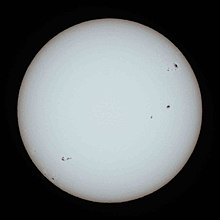
Back Geeldwerg Afrikaans Nana amariella AN نجوم النسق الأساسي من النوع G Arabic Estrella de tipu-G de la secuencia principal AST Жоўты карлік Byelorussian Жоўты карлік BE-X-OLD Жълто джудже Bulgarian Nana groga Catalan Žlutý trpaslík Czech Сарă карлик CV

A G-type main-sequence star (spectral type: G-V), also often, and imprecisely, called a yellow dwarf, or G star, is a main-sequence star (luminosity class V) of spectral type G. Such a star has about 0.9 to 1.1 solar masses and an effective temperature between about 5,300 and 6,000 K. Like other main-sequence stars, a G-type main-sequence star converts the element hydrogen to helium in its core by means of nuclear fusion, but can also fuse helium when hydrogen runs out. The Sun, the star in the center of the Solar System to which the Earth is gravitationally bound, is an example of a G-type main-sequence star (G2V type). Each second, the Sun fuses approximately 600 million tons of hydrogen into helium in a process known as the proton–proton chain (4 hydrogens form 1 helium), converting about 4 million tons of matter to energy.[1][2] Besides the Sun, other well-known examples of G-type main-sequence stars include Alpha Centauri, Tau Ceti, and 51 Pegasi.[3][4][5][6]
- ^ "Why Does The Sun Shine?" Archived 2006-09-09 at the Wayback Machine, lecture, Barbara Ryden, Astronomy 162, Ohio State University, accessed on line June 19, 2007.
- ^ "Sun" Archived 2007-06-16 at the Wayback Machine, entry at ARICNS, accessed June 19, 2007.
- ^ "Alpha Centauri A" Archived 2019-04-28 at the Wayback Machine, SIMBAD query result. Accessed on line December 4, 2007.
- ^ "Tau Ceti" Archived 2019-04-28 at the Wayback Machine, SIMBAD query result. Accessed on line December 4, 2007.
- ^ "51 Pegasi" Archived 2019-04-28 at the Wayback Machine, SIMBAD query result. Accessed December 4, 2007.
- ^ "Type G Stars". www.whillyard.com. Retrieved 2022-04-22.
© MMXXIII Rich X Search. We shall prevail. All rights reserved. Rich X Search